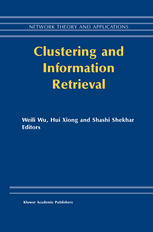

Most ebook files are in PDF format, so you can easily read them using various software such as Foxit Reader or directly on the Google Chrome browser.
Some ebook files are released by publishers in other formats such as .awz, .mobi, .epub, .fb2, etc. You may need to install specific software to read these formats on mobile/PC, such as Calibre.
Please read the tutorial at this link: https://ebookbell.com/faq
We offer FREE conversion to the popular formats you request; however, this may take some time. Therefore, right after payment, please email us, and we will try to provide the service as quickly as possible.
For some exceptional file formats or broken links (if any), please refrain from opening any disputes. Instead, email us first, and we will try to assist within a maximum of 6 hours.
EbookBell Team

5.0
108 reviewsClustering is an important technique for discovering relatively dense sub-regions or sub-spaces of a multi-dimension data distribution. Clus tering has been used in information retrieval for many different purposes, such as query expansion, document grouping, document indexing, and visualization of search results. In this book, we address issues of cluster ing algorithms, evaluation methodologies, applications, and architectures for information retrieval. The first two chapters discuss clustering algorithms. The chapter from Baeza-Yates et al. describes a clustering method for a general metric space which is a common model of data relevant to information retrieval. The chapter by Guha, Rastogi, and Shim presents a survey as well as detailed discussion of two clustering algorithms: CURE and ROCK for numeric data and categorical data respectively. Evaluation methodologies are addressed in the next two chapters. Ertoz et al. demonstrate the use of text retrieval benchmarks, such as TRECS, to evaluate clustering algorithms. He et al. provide objective measures of clustering quality in their chapter. Applications of clustering methods to information retrieval is ad dressed in the next four chapters. Chu et al. and Noel et al. explore feature selection using word stems, phrases, and link associations for document clustering and indexing. Wen et al. and Sung et al. discuss applications of clustering to user queries and data cleansing. Finally, we consider the problem of designing architectures for infor mation retrieval. Crichton, Hughes, and Kelly elaborate on the devel opment of a scientific data system architecture for information retrieval.